Etude

Technology breakthroughs continue to reshuffle industries and shift competition, changing the ways we work, manage and organize. The persistence and power of this ongoing digital transformation is evident in the results of our most recent Management Tools & Trends survey, as managers embrace digital tools like Advanced Analytics and the Internet of Things. Just as striking, digital natives and established technology companies are turning novel management and organizational concepts into operational realities as they move away from hierarchical structures and embrace Agile Management, accelerating innovation and pushing power and responsibility to the front line.
The broad move to empower teams is happening across industries, from small regional firms to major multinationals, and in both emerging and developed markets. Of the 1,268 managers who participated in Bain & Company’s latest Management Tools & Trends survey, conducted in the fall of 2017, 4 out of 5 agreed with the idea that today’s business leaders must trust and empower people, not command and control them. Only 5% disagreed (see Figure 1).
Bain has surveyed executive behavior and attitudes 16 times over the past 25 years, each survey a snapshot of a moment in history (see the sidebar, “A history of Bain’s Management Tools & Trends survey”). Combined, they span a full range of economic cycles, becoming something more like a motion picture, elucidating long-term shifts and exposing momentary fads. Business cycles and changing theories of management affect the popularity of individual tools and trends (see Figure 2). So do more specific factors, such as how well an individual tool works.


Topping the list of the 25 most popular management tools (see Figure 3) is Strategic Planning, the process of determining what a business should become and how it can best achieve that goal. Perennially among the top 10, this time Strategic Planning ranks No. 1 based on global usage (see Figure 4)—a reflection, at least in part, of the challenges and opportunities raised by digital technologies. As companies navigate this so-called fourth industrial revolution, hoping to grow and thrive in a quickly changing environment, understanding how to be of value to customers only becomes more vital. It’s little surprise, then, that Customer Relationship Management, which focuses on understanding customers and responding quickly to their shifting desires, ranks No. 2 on the list, close behind Strategic Planning.

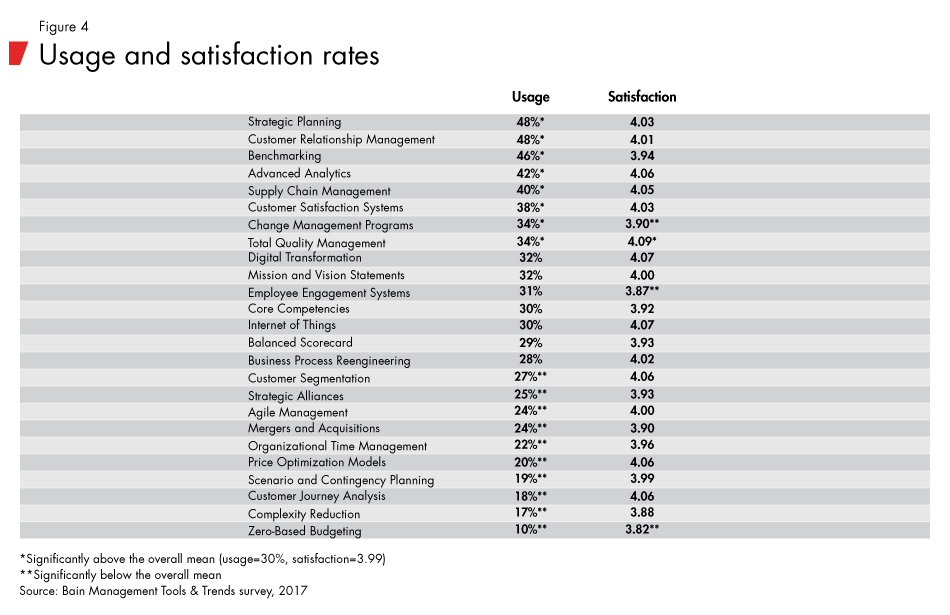
Tool use can vary by region. In Asia-Pacific, Advanced Analytics is the most-used tool. But across the board, Total Quality Management’s systematic approach to quality improvement earns the highest satisfaction rates, including particularly strong reviews in China and India.
The survey, which asked executives about their tool use over the prior 12 months, gives a good sense of each tool’s popularity today, but there is also a lot to learn from looking back at a tool’s historical trend. It is common, for example, for a tool to become popular quite suddenly but then fall out of fashion after a few cycles if it has not established strong user satisfaction. That doesn’t mean it is gone for good, however. Many tools return in one form or another, improved and often with greater impact. In the 2000s, Knowledge Management rocketed up our list. By 2006, 69% of managers reported using it. But the tool, aimed at increasing the generation of meaningful, actionable information, suffered from low user satisfaction over the 14 years we included it in the study. Today, new approaches to this same business challenge have evolved, some using artificial intelligence and machine learning.

Top 10 Tools through the Years
This interactive chart shows the most popular tools cited by executives in the latest survey and how they compare to the most widely used tools of past years.
The general use of management tools rises and falls in cycles, often reflecting the macroeconomic environment and competitive dynamic. Tool use is now near its low. Managers report using an average of 7.5 tools, whereas a decade ago they were using twice that number (see Figure 5). Even many of the most popular tools are well off their historical highs. No. 1, Strategic Planning, for example, is used by 48% of respondents today, but in 2006, 88% of managers were using it.
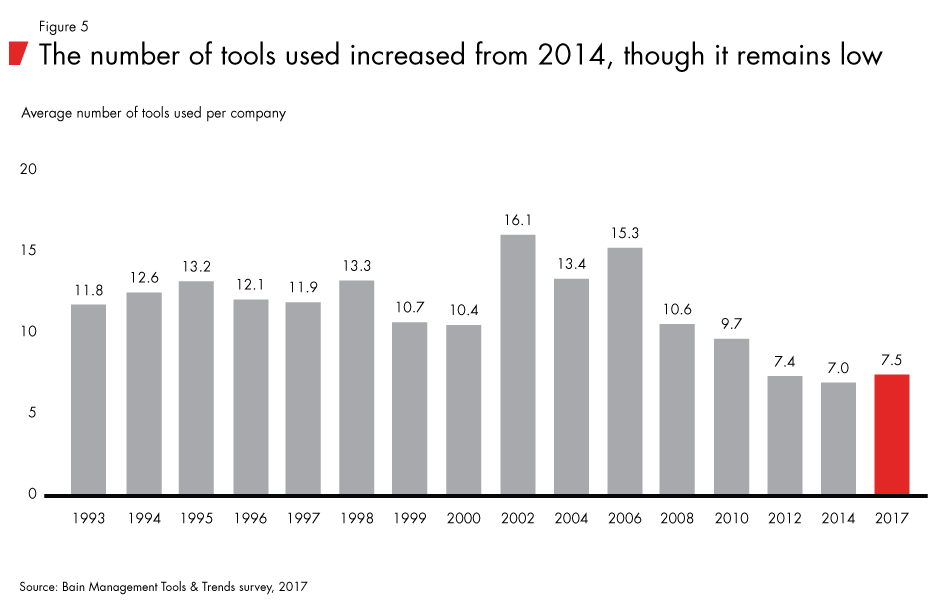
In 2002, when tool use hit its peak of 16.1 tools per company, managers were battling an economic slump. The dot-com bubble had burst, a series of corporate accounting scandals had marred major corporations and the September 11 attacks had set the world on a new geopolitical trajectory. Looking to boost growth, managers embraced tools.
Something we know from the survey’s history is that tools generally do not work well when executives use a lot of them on a limited basis as short-term fixes. Major efforts consistently lead to better tool satisfaction scores than limited efforts do. Tools like Digital Transformation and Supply Chain Management only work when employed broadly throughout an organization, and some tools possibly shouldn’t be used on a limited basis at all. The Internet of Things, Customer Segmentation, Advanced Analytics and Total Quality Management are among the tools that are much better reviewed as part of a major effort than as part of a limited one (see Figure 6). If the broad decline in the number of tools being used in recent years reflects a sharper focus on the ones that work best—an emphasis on depth and fit over quantity and buzz—that could be all to the good.
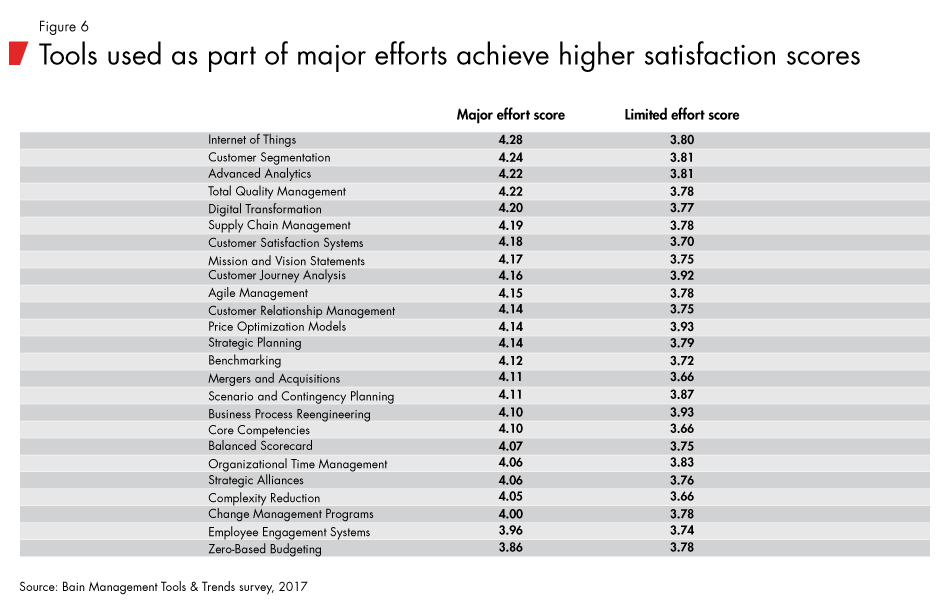
Among the tools on the upswing are Customer Satisfaction Systems, designed to improve retention of customers, employees and investors, and Digital Transformation, which integrates digital technologies into an organization’s strategy and operations. Digital Transformation’s usage has nearly doubled since our last survey.
On the decline: Mission and Vision Statements. Used by 32% of respondents today, these tools were once nearly ubiquitous; 88% of managers reported using them in our first survey in 1993. Scenario and Contingency Planning also has fallen, from 70% usage at its peak to 19% today. Strategic Alliances has fallen from a high of 69% to 25%, and Total Quality Management, which peaked at 73% in 1995, is now used by only 34% of managers.
It’s worth paying close attention to how a tool’s usage and satisfaction levels compare. We generally find a positive correlation between satisfaction and usage. Over time, tools with high usage but low satisfaction levels, like Knowledge Management, gravitate toward a more normal relationship. Either their use declines or the capabilities of the tool improve, bringing up satisfaction scores.
If this pattern continues to hold, the latest survey’s results indicate that Benchmarking—the No. 3 tool by usage, but with a satisfaction score below the mean—may need substantial improvement in order to maintain its share (see Figure 7). Conversely, Customer Journey Analysis, which helps a company see its products or services through its customers’ eyes, has high satisfaction but is used by only 18% of respondents today. That figure could grow significantly. However, as with any tool, companies need to ensure that they are using it for the right reason and in the right way.
Another way of assessing a tool’s success is to look at the relationship between its promoters and its detractors (see Figure 8). By this measure, too, Customer Journey Analysis looks quite strong.

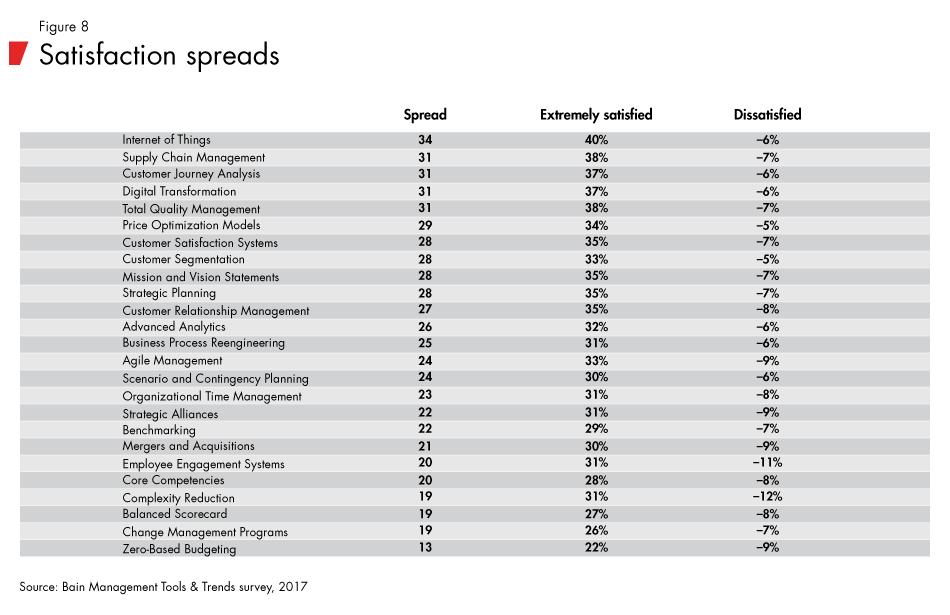
In addition to looking at predictive trends like the relationship between tool use and tool satisfaction, we ask managers for their opinions. The tools they expect to enjoy the greatest increase in usage in the coming years are Complexity Reduction and Scenario and Contingency Planning. It bears noting, however, that this type of prognostication is hard to get right. In 2014, respondents predicted that these same two tools would gain the most in the years to come, but neither cracked the top 10 in the latest survey.
The respondents to our survey at times display a high level of optimism bordering on overconfidence. When asked to agree or disagree with the statement “Our company adapts to change faster and better than our competitors do,” for example, only 20% of respondents disagreed. Some 63% describe themselves as disciplined cost managers who focus their spending on strategic priorities, and yet a similar number complain that excessive complexity is raising costs and hindering growth.
Managers too often underestimate the evolution that a tool, especially a new one, will need to undergo, and the work it will take them to become skilled at deploying it. Tools often get better over time, but so does execution. By failing to recognize that, an overconfident manager may be quickly passed by competitors.
Today, enthusiasm for management tools is highest among Asia-Pacific executives (see Figure 9). Already reporting tool satisfaction levels above those of their North American counterparts in prior surveys, the group for the first time also reports using tools at a much higher rate—an average of 12.2 tools, up from 8 in 2014, and nearly twice North America’s average. Asia-Pacific managers are adopting new tools faster than their counterparts in established markets are.
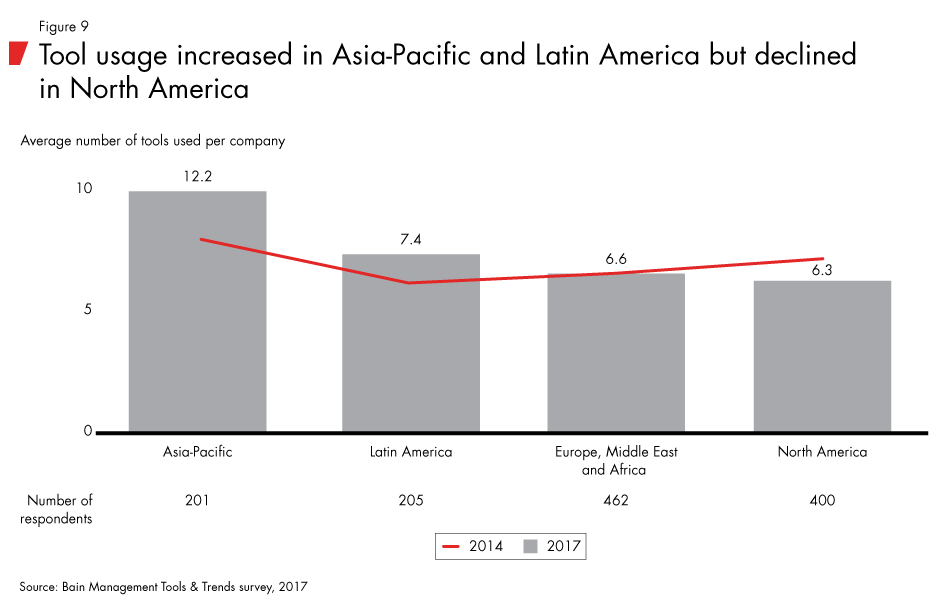
The survey provides a wealth of data, from geographical variations to specific tool trends and broad manager sentiment. Looking at the results in the context of prior surveys, we see five important trends: growing rejection of bureaucracy and complexity, the embrace of digital, a focus on building corporate culture, ongoing emphasis on strengthening customer relationships and renewed interest in cost control.
Trend 1: Backlash against bureaucracy and complexity
Managers moving away from “command and control” leadership styles are also straining against bureaucracy and the corporate complexity it can bring. In this survey, 6 out of 10 respondents report that excessive complexity is raising their firms’ costs and hindering growth. Over half believe that bureaucracy and excessive levels of hierarchy are putting them at a competitive disadvantage.
As digital technology fuels upstarts and unexpected competition from new rivals, supporting growth has become central for many companies. Yet 4 out of 10 respondents report that their firms’ structure and culture impede profitable growth. Part of the answer is creating an effective culture. Managers continue to argue that culture is at least as important as strategy for business success, a position the majority have held for many years. Today, 75% agree.

Trend 2: Making the most of digital technology
Across all industries and regions, digital technology is a dominant factor. Two-thirds of executives report that digital disruption and software solutions are rapidly changing the rules of competition in their industries. And they are making good use of tools aimed at helping them address these shifts. Use of Digital Transformation is increasing, and respondents report high levels of satisfaction with it, as they do with other digital tools, including the Internet of Things and Advanced Analytics.
Managers are upbeat about their ability to capture data and analyze it successfully. Despite other evidence that many companies struggle to get the most out of analytics, more than half of respondents to this survey claim they are able to capture and exploit the full value of data from all corners of their companies. Fully half rate their Advanced Analytics capabilities as world class.
When an important new tool emerges, we add it to our survey, and we added three in 2017. Two of those, Agile Management and the Internet of Things, reflect the influence of technology in management today. Agile, which uses adaptive methods pioneered by Japanese manufacturers to increase the value of innovation, is popular among software developers. A new concept still for many managers, it is not yet widely used, but its high satisfaction rankings among those who do use it point to growth moving forward. Combined with Advanced Analytics, the Internet of Things—a network of data-producing connected sensors and smart devices—could become a powerful tool, helping to monitor equipment and improve products and services.
How comfortable managers are with their level of digital savvy depends in part on the industry. Two-thirds of technology and telecommunications respondents feel they have world-class Advanced Analytics capabilities, for example, but only 4 out of 10 firms in healthcare, utilities, energy and services agree.
Emerging-market executives were most likely to say that their firms capture and exploit the full value of data from all corners of the company, and that their Advanced Analytics capabilities are world class. Advanced Analytics moved into the top four tools, in part driven by its high level of popularity in Asia. Managers in North America, in Europe and from small companies are less upbeat about their Advanced Analytics results so far, registering relatively low user satisfaction. Some of this disconnect might be explained by emerging markets’ relatively recent embrace of data analytics, a kind of newlywed bliss. In the US and Europe, where companies have longer experience with data analytics, the hard work of pulling data and mining it for insights and results may be tempering their enthusiasm.
As always, it is easier to talk about change than to make it happen. Nearly 6 out of 10 executives surveyed say their companies talk about digital strategies, but are not operationalizing them fast enough. Half say they will face significant gaps between their IT capabilities and their business needs over the next three years, and almost as many report that their IT systems are constraining profitable growth.
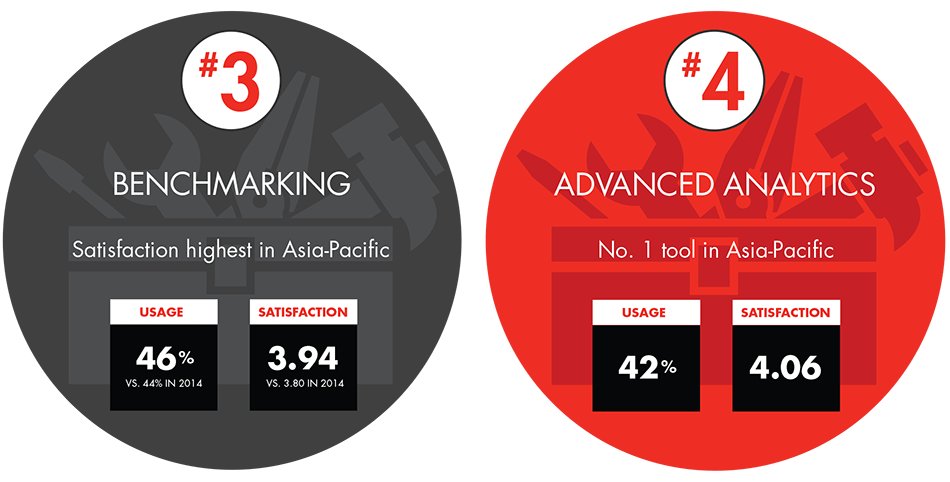
Trend 3: Developing a strong corporate culture
Three-quarters of those surveyed agree that culture is at least as important as strategy for business success. It is not easy, however, to cultivate a strong corporate culture. And unfortunately, an effective tool for establishing one—Vision and Mission Statements—seems out of favor with our respondents. Only 32% report using this once-popular tool.
At a time of great change, it is a mistake for a company to move away from a clear statement of mission and vision. The faster business moves, the more important it is for all employees to know and live their organization’s values and purpose. Mission statements can be a strong aid, empowering workers to march toward a common purpose. Beyond platitudes engraved on a Lucite block or hanging from a banner, a bold mission that employees know and embrace is a highly valuable corporate asset. Yes, the front line must be empowered to decide how to execute it, but the strategy itself has to be clear, and without a guide, it is easy to get lost.
Mission and Vision Statements have a role to play in solidifying a corporate culture, and their satisfaction ratings are high enough to indicate they deserve high usage as well.

Trend 4: Focus on customers
The need to put customers at the center of any business has been a clear theme of this survey stretching back years. Yet it has never been more important. The tools for understanding and responding to customers are getting better, and companies are getting better at using them. When we asked managers about their organization’s most important priority over the next three years, focusing on customer loyalty was the No. 2 answer, just behind revenue growth. In one of the largest markets—India—it was No. 1.
Great companies today focus on customers more than on competitors. Disruptive companies focus very little on competitive analysis or trying to copy what competitors are doing. Instead, they zero in on customers. They plan to reinvent their industries. To them, competitors are prey. Upstarts are not trying to be like their rivals; they are figuring out how to eat them alive.
Competitor-focused tools like Benchmarking remain widely used but do not have the satisfaction scores you might expect. By contrast, Customer Segmentation, Customer Relationship Management and Customer Satisfaction Systems all scored well. The tools seem to be having an impact. In 2004, 65% of respondents agreed that insufficient consumer insight was hurting their performance. Today, that figure has dropped to 45%.
Customer Journey Analysis joined the survey for the first time in 2017. It consists of mapping and analyzing the sum of all experiences a customer has while interacting with a company or brand. Its aim is to provide insight that companies can use to design products and services that help customers achieve their objectives as effectively and efficiently as possible. Though the tool just made its debut on the survey, it tied for the third-highest satisfaction ranking.
Interestingly, executives seem less satisfied with tools aimed at employees. Employee Engagement Systems have a low satisfaction ranking, but they are quite similar in many ways to customer engagement tools. Are the tools for customers really that much better? Or do managers not like the substance of the employee feedback they are receiving?

Trend 5: Watching costs at a time of growth
In prior surveys, tools and trends concerned with cost reduction generally became a focus in times of economic hardship. Now they are climbing at a time of growth. Six out of ten respondents feel that excessive complexity is raising their firms’ costs and hindering their growth, and more than half feel that bureaucracy and excessive levels of hierarchy are putting them at a competitive disadvantage.
By reducing costs, companies can come up with the funding required to sustain growth. Growth too often leads to expensive complexity, and that complexity then strangles further growth. Fighting back against cost and complexity has become a growth imperative.
Managers looking to discipline spending have good tools to work with. Zero-Based Budgeting is an idea that dates back to at least the days of Jimmy Carter, but now—with better benchmarks, automated ledgers and other improvements—it should be more widely used than our survey results suggest it is. It’s possible that companies are not fully utilizing its current capabilities, or that the tool needs to become easier to use.
Zero-Based Budgeting and another cost-focused tool, Business Process Reengineering, are especially popular in Asia-Pacific, a region of higher growth rates. Some 37% of respondents from emerging markets report using Business Process Reengineering, vs. 22% of established-market managers.

Conclusion
This is a time of rapid change in business and markets, with new competitors emerging every day and customers untethered from traditional loyalties. Respondents feel both challenged by this environment and less capable of handling change. In 2014, 75% of respondents felt that their ability to adapt to change was a significant competitive advantage. Only 13% disagreed. Today, only 56% feel that their companies adapt to change faster and better than competitors do.
As companies seek to grow and innovate, and to structure and manage their operations to support those goals, we offer the following four suggestions for getting the most out of management tools. Sharpened over two-and-a-half decades of asking executives about the trends affecting them and their most useful tools, and based on our own experience, these rules have stood the test of time.
- Get the facts. Every tool has strengths and weaknesses. And tools’ usefulness can change over time. To succeed, companies need to understand the full effects of each tool and then combine the right ones in the right ways at the right times. Peruse the research and talk to other tool users. Don’t naively accept hyperbole and simplistic solutions.
- Champion enduring strategies, not fleeting fads. Line managers and tool experts don’t always have perfectly aligned agendas. Tool experts may have an engaging perspective, but managers must manage. Companies should champion realistic strategic directions and view tools as an aid, not a panacea.
- Choose the best tools for the job. Managers should take a rational approach to selecting and implementing tools. A tool will only improve results to the extent that it identifies customers’ unmet needs, builds distinctive capabilities, exploits competitor vulnerabilities and develops breakthrough strategies.
- Adapt tools to your business system—not vice versa. Our research shows, for example, that major efforts achieve significantly better tool satisfaction scores than limited ones do. If management can only engage in a limited effort, it may be best to avoid using some tools. It’s also important to keep in mind that satisfaction scores for the same tool can vary widely depending on company size and region.
Darrell Rigby, a partner with Bain & Company’s Boston office, has conducted Bain’s Management Tools & Trends survey since 1993. Barbara Bilodeau is the director of Bain’s Advanced Analytics Group in the New York office.
A history of Bain’s Management Tools & Trends survey
Since 1993, Bain & Company has surveyed executives around the world about the management tools they use and how effectively those tools have performed. The objective: to provide managers with information they need to identify and integrate tools that will improve bottom-line results, and to understand how global executives view their strategic challenges and priorities.
We focus on 25 tools, honing the list each year. To be included in our survey, a tool needs to be relevant to senior management, topical and measurable. By tracking the tools companies are using, under what circumstances and how satisfied managers are with the results, we have helped them make better choices in selecting, implementing and integrating the tools to improve their performance.
With this, our 16th survey, we now have more than 14,700 respondents from more than 70 countries in North America, Europe, Asia, Africa, the Middle East and Latin America, and we can systematically trace the effectiveness of management tools over the years. As part of our survey, we also ask executives for their opinions on a range of important business issues. As a result, we are able to track and report on changing management priorities.
For a full definition of the 25 tools, along with bibliographical resources for each one, please see the Bain & Company booklet Management Tools 2017: An Executive’s Guide.













